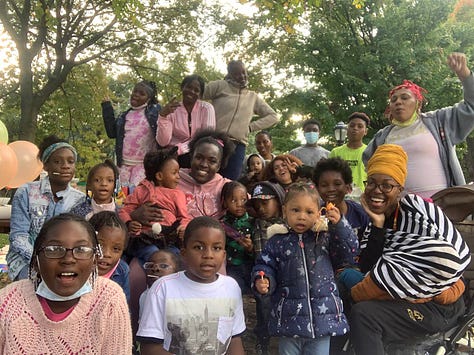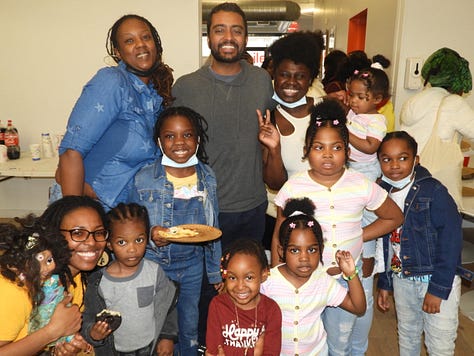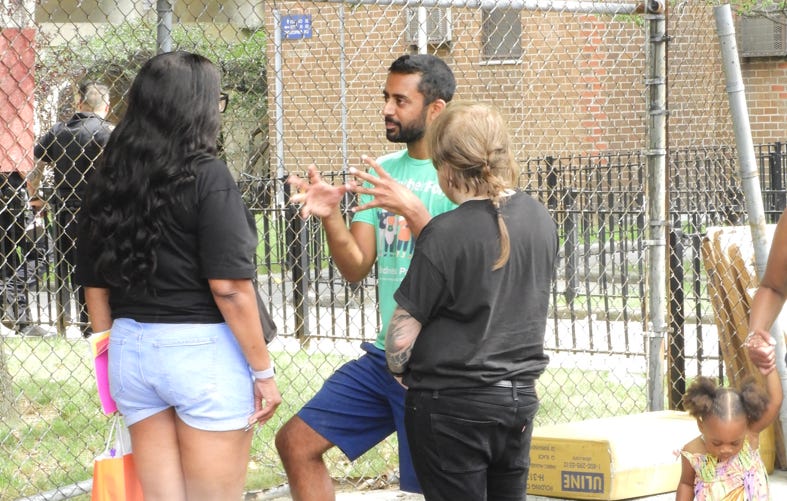Putting the principles of belonging, reciprocity, and care into practice
A Q&A with Teju Ravilochan, Founder of GatherFor
This week, we’re featuring a Q&A with another Connective Tissue subscriber, Teju Ravilochan. Our friend Teju is the founder of GatherFor, an organization built on the belief that “in community, we have everything we need.” GatherFor organizes neighborhood teams to support one another like a family, then links these teams together to build the neighborhoods they want. Teju and GatherFor exemplify what it looks like to put the principles of solidarity, proximity, and reciprocity into practice each day—and they are doing so in Brownsville, Brooklyn, home to the largest concentration of public housing in North America.
A conversation with Teju is an invitation to imagine a different future built on belonging and care. Some questions he raises include:
What does it take to truly center neighbors to shape their neighborhoods?
How can celebration help cultivate a community’s collective efficacy?
What could it look like to reimagine and re-embed care within neighborhoods?
What is possible when we embrace mutuality and reciprocal relationships?
So consider this an invitation—actually, a forceful encouragement—to read our full Q&A with Teju. And if you want to learn more about GatherFor’s work and Teju, you can visit their website, follow the organization on Medium, and email Teju directly (teju@gatherfor.org).
- Sam
How would you begin to describe what you’re doing with GatherFor?
All of GatherFor is grounded in the belief that in community we have everything we need. What we're after is community sufficiency—the idea that the needs of the people who live in a neighborhood can be met by the people who live in that neighborhood.
We're pursuing that by organizing neighbors into two kinds of teams: neighbor teams and action teams. Neighbor teams are groups of five neighbors that form a family of sorts. They meet regularly, share stories, and become friends. In the process, they wind up watching each other's kids, pooling funds to pay bills, visiting each other in the hospital, helping each other find jobs, giving people a place to crash when they don't have a place to go, bringing people food where they don't have it—all the kinds of things you would hope for a good friend to do for you.
We support these neighbor teams with a couple of things. We give them $300 a month for in-person gatherings—museum visits, dinners and potlucks, anything like that—they get to decide and they have the funds to do it. We also help them start what's called a Susu in Caribbean culture: everyone pools money in equal amounts, and then gives the whole pool to one person. We match that up to $500, so that’s up to $1000 that goes to one person in the group, which they can use however they choose. The giving rotates, so every member of the group gets their turn. Finally, we unite all these neighbor teams every month at a town hall, where they talk about how things are going and what they want to improve in the neighborhood.
It's that type of practice that has led us to our second kind of team—action teams—which are groups of neighbors that are trying to address a particular issue in their neighborhood. We currently have four action teams focused on housing, entrepreneurship, mental health, and childcare and youth activities. Each action team has a budget of $5,000 to use as they wish to make progress in their respective areas. Each action team starts by assembling an event where they share their stories and hopes, pull in resources, and build a network. After that event, we'll give them a couple of months to achieve a concrete but small, measurable goal within their theme. For example, the challenge for the Housing Action Team might be “pick three people in our community who are facing housing insecurity and get them into a stable housing situation in the next three months.”
For a team of neighbors to band together and mobilize those resources, it helps the community build that muscle and that skill-set of community sufficiency. They are cultivating belonging and bringing about the neighborhood they want to see.
Where does GatherFor’s work take place?
All of this is happening in Brownsville, Brooklyn. It’s home to about 100,000 people, has the largest concentration of public housing in North America, and is a community of almost entirely black and brown people. Tragically, it’s the human junkyard of New York. Because all these big public housing projects were built there, it's not a very desirable place to live. It's where the city sends folks that it doesn't really have another place to put (e.g., undocumented, unhoused, formerly incarcerated). It's historically been a place of a lot of crime and gang violence. It’s a hard place.
But people also have each other’s backs in Brownsville, which is what drew me to the neighborhood in the first place. Even though there are all of these challenges at play in Brownsville, there is this incredible culture: people are very proud of Brownsville, people really flock together, people watch out for each other.
In the past, I’ve heard you talk about the concept of relational wealth. Can you tell me a little bit about what you mean by it and how it shapes your work with GatherFor?
Etymologically, wealth is connected to health: both words come from the word for wholeness. When we’re healthy, we’re whole. When we’re wealthy, we’re whole. What does wholeness mean? It’s when we're meeting all of our needs—for food, for safety, for security, for companionship, for joy.
There's a Seneca elder named Terry Cross, who defines culture as one group of people's preferred way of meeting their needs. In our culture, we meet our needs through the acquisition of financial wealth. We get a job, we make money, and we use the money to buy our housing, to buy our food, to essentially do everything.
But that's not the only way that cultures can meet their needs. For most of human history, we have relied on our relationships with each other. We've lived in communities where, if your house burns down—you didn’t have insurance that you'd been paying, you had your neighbors come and rebuild your house for you. You didn’t have childcare that you'd been paying for, you had your neighbors to watch your children. This is relational wealth: it's meeting our needs through relationship.
We are profoundly interconnected and profoundly reliant on others. Relational wealth is this way of remembering who we really are—that in community, we can meet our needs together. This is the fundamental work of GatherFor.



Last summer, you hosted a Kindness Party in Brownsville to drive “accountability through celebration.” How did the Kindness Party come about? What ended up happening as a result?
I was invited to speak about GatherFor at a tenant association meeting for Glenmore Plaza—one of the big housing projects in Brownsville—where they brought all the residents together to talk about their experiences in the building. I’ve never heard so many angry people in one room. They were particularly frustrated with the manager of the building, who hadn’t made any repairs in a long time. One woman even shared a story about how she had a grab bar in her bathroom—the bar that you use to pull yourself up if you're elderly or if you have physical disabilities—and it had rotted so bad that it came out of the wall. She fell back and hit her head, and ultimately needed to get brain surgery. I was shocked. And other people were like, “Yeah, exactly. This is what's happening to us.”
When it was my turn to share, I didn't feel comfortable presenting what I had. So I just asked questions, like, “have you ever tried speaking to the housing authority with a single voice to get these repairs addressed?” They said “no.” And as I dug further, they didn't have trust, they were afraid of each other, they just wanted to keep their heads down and mind their own business. People were doing drug deals in the residence, people were passed out in the hall with needles in their arms, unhoused people were breaking in and urinating in the stairwells. There were a lot of difficult things happening in the development. When I finally talked to some people about GatherFor, they were like “look, whatever you're saying sounds nice, but we can't think about it because we got these other pressing issues.”
Then I spoke to a mentor of mine who does community organizing work, and he said a great way to build trust with people is to help them with their actual issues. So I went back to this community, and I proposed that we all come together, organize, and hold the New York City House Authority (NYCHA) accountable. Some people yelled at me. Some people were very upset. They had been frustrated for years, and I understand how difficult it was to think about a solution. But there were eight people—out of the 50 or so at this meeting—who were willing to explore the idea. So we started going door-to-door to collect people's repair needs from their houses and documenting them in a big spreadsheet.
Around that time, a queer friend told me about a block party they organized as a way of dealing with discrimination they experienced for being non-binary. It worked in helping them meet the people who were harassing them and getting that harassment to stop. They even started to respect my friend. That story inspired me and I said, “What if instead of yelling at NYCHA, which I'm sure we all want to do, we celebrate them for doing the right thing? What if we say whatever your past failures are, do the right thing now and do it quickly, and we will celebrate you and we will make it known?” And so we went to NYCHA with that spreadsheet of all the repair needs and said, “Here's what we want you to do. If you do it within the next three months, we're organizing a block party on August 12th, and we would love to have the press and everyone in our community there. We would love to say NYCHA made this happen, NYCHA made these repairs. We would love to celebrate you for doing it.”
We had no idea if it was going to work. But NYCHA accepted the invitation and they made 1600 repairs in 60 days, which were 87% of the repairs that residents had requested. And since that time, they've made over 5000 repairs and they have responded to almost all the issues that residents have been legitimately complaining about. The Kindness Party was “accountability through celebration.” We were inviting NYCHA to be accountable—not by making them the villain, but by saying, “Hey, here's a deadline, but we're going to celebrate you if you get it done.” And it worked.
Do you think it was more of the “carrot” of the celebration or the “stick” of the potential negative press that led NYCHA to make these changes?
The people at NYCHA were really motivated by the teamwork aspect of it. A lot of them come from these communities and they have lived in NYCHA housing. It’s easy to paint NYCHA with a broad brush—far away people who don't understand what we're going through—but some of the people in that institution have first-hand experience with living in public housing. And they're rarely given recognition for their hard work.
They had the chance to do something where they could be recognized and have pride in doing. But they also had the pressure getting something big done with not quite enough time to do it. I think all those things led to an exceptional result. If it had been only “stick,” we wouldn't have seen the same results. If it had only been “carrot,” we wouldn't have seen the same results. Bringing them together led to the result that we received. And now there's a much more positive relationship between NYCHA and Glenmore Plaza. This means that, in the long-term, there’s a stronger likelihood that this responsive support can continue.
You’ve mentioned to me recently that you’ve been thinking a lot about the concept of care. How are you considering care in relation to GatherFor’s work?
My partner Abby, who is an OBGYN, told me about this program that's practiced at her clinic called Centering in Pregnancy, which gathers 8-10 moms who are due around the same time and groups them together. Instead of seeing their OBGYN one-on-one, they see their doctor as a group for two hours. This gives them time for discussion and Q&A, and they talk about all sorts of issues—from nutrition, to setting up the baby's room, to instilling family traditions in the baby's life. They build all this trust and incredible depth of insight, and then the program ends when the babies are born. So Abby asked, “what if you just picked it up from there and started doing what GatherFor does, but with these mom groups?”
That's exactly what we want to try to do. We will work with moms whose children were born at the same time and help them raise their kids together. By forming these groups, they can support each other in those early years, but hopefully for life. I've spoken to people from mommy groups, and they've said, “oh, yes, my best friends now are from 50 years ago when we all had our kids together and we were in a mommy group.” There is a very profound bond that can be built. Then, in Okinawa, Japan, there is this practice called Moai, which are lifelong groups that kids are placed in by their mothers not long after they're born. These kids end up helping each other and supporting each other throughout their lives together.
Between the mom groups and the Moai groups, it gives us the opportunity to create these lifetime cohorts of support. People who will really journey with you across two generations of holistic well-being. Childcare is a $24,000 annual expense for the average American family—maybe that goes away, because you have this group of five moms that you really trust and who you're raising your kids with. There’s even the potential that the whole community gets invited into caring for its children. That's the thing that's been missing from our work with GatherFor—the centering of children. Our neighbors tell us that the most important thing in their lives is giving their kids a good life. And if we really listen to that, what does it mean to center those kids?
This is our aspiration. If anyone is reading this and wants to talk about doing this together, or share ideas or insights, please reach out. Our hope is that we can build this new cultural practice of being in deep community together for life—and do so across generations.
What do you wish others understood about this work?
If you think about the hardest moments that you've been through in your life, what is it that you have needed in those moments? What is it that you've longed for?
If I ask myself that question, what I have wanted most is the accompaniment of a loving friend or family member who can hold me in a space of non-judgment and just be with me. When my grandparents died, there was nothing that could be done and there was nothing to be solved. But having people who would listen to me tell stories about them—that made a huge difference. These are hard moments and the things I needed most in these moments were community, belonging, and friendship. This is a thing our hearts hunger for because we know that if we belong, everything will be okay. We can figure out housing, food, safety, we can do it all. But we need each other. That’s what is at the core of this work.
I want to ask people to consider, as they think about their own lives, where are you living in this practice of supporting others and being supported by them? A big part of this is embracing reciprocal relationships. Are we in deep relationships of give and take? Are we letting others support us? Are we supporting one another during our most difficult moments? We all have everything we need to do that: we all have the capacity to be present, to listen, to share our stories, to ask questions. All of these things that feel revolutionary and liberatory come down to these very simple capacities that we all have.
This is not the work of extraordinary people. It's the work of ordinary people.





